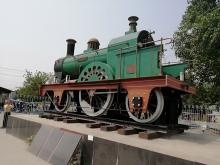In last week of June, 2005 I had gone to Roorkee. My destination was to see the great Solani Aqueduct, part of the Ganges Canal conceived in the 1840s by Colonel Sir Proby Thomas Cautley. It was during the construction of this aqueduct that the first rail ran in India.
The aqueduct is a structure of fifteen arches spanning a valley a thousand feet wide. The river below, the Solani, is an intermittent stream whose broad valley is usually dry as a bone. The valley is so shallow that the ground is never more than about 25 feet below the floor of the aqueduct. Solani Aqueduct was built 172 feet wide -- 150 feet for the canal itself, the rest for a two-lane road and railings. Stones sunk nearly 20 feet under the bed of the river support the arches, and the work was done so well that upon removal of the "centerings" -- the wooden frameworks used in constructing the arches -- the keystones sagged only an eighth of an inch. Some 11 million cubic feet of masonry were used in the aqueduct -- 85 million bricks The frontispiece showed two elegant details: decorative iron railings imported from England and pairs of large stone lions, made locally and placed at each end of the aqueduct.
While constructing the aqueduct British engineers wanted to bring a large quantity of clay and other earth materials from nearby Piran Kaliar area situated 10 Kms away from Roorkee. This necessity to bring earth and other materials compelled the engineers to invent the possibility of running a train between the two points. The line laid was 4 feet 8 and half inch gauge. Engine was brought from England in 1851. It was 2-2-2 T loco manufactured by E.B.Wilson. The engine was named Thomason after the Executive engineer, Thomson, who conceptualized and successfully completed the ambitious mega plan to run train here.
Initially, two wagons were attached to the engine with a capacity to load 180 to 200 tons of material. The train used to cover a distance of two and half miles in 38 minutes between Roorkee and Piran Kaliar with a speed of four miles per hour The train remained operation for nine months until the locomotive caught fire one day, in 1852. But by the time, the construction of the aqueduct had been completed
World Bank in 1984 agreed to help fund the reconstruction of the canal, known as the "upper" Ganges Canal. The reconstruction of the Upper Ganges system included a new Solani Aqueduct, an ugly bridge of prestressed concrete beams.
Today the old bridge stands nearby: gracefully arched plastered brick, neatly dated with a plaque from the 1840s. The decorative iron railings have disappeared and the stone lions have been moved upstream to a new location. The pillar at two ends proudly carries the statutory warning “ Photography prohibited”.
Railways have installed a plaque at Roorkee station, which states the first run of Thomason, was on Dec 22, 1851.

